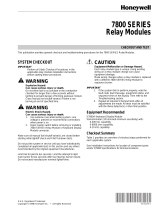Page is loading ...

APPLICATION
The
118367A
Swivel Mount provides an adjustable
mounting support for ultraviolet flame detectors. The
swivel mount fastens outside a furnace wall, and a
sighting pipe and flame detector are attached to the
swivel mount. Adjustment of the detector’s view of the
flame is possible after the mount is installed (Fig. 1).
INSTALLATION
WHEN INSTALLING THIS PRODUCT.
. .
1. Read these instructions carefully. Failure to follow
them could damage the product or cause a hazardous
condition.
2. Check the ratings given in the instructions and on
the product to make sure the product is suitable for your
application.
3. Installer must be a trained, experienced, flame
safeguard control technician.
4. After installation is complete, check out product
operation as provided in these instructions.
LOCATION
Refer to the flame detector and burner manufacturer’s
instructions before beginning installation. Consider any
special mounting requirements of the detector when
locating the swivel mount. Follow instructions carefully
to make the best possible application of the flame
detector.
PLAN LOCATION OF SIGHTING PIPE
The location of the sighting pipe is the most critical part
of the installation, since the detector output current
depends on the correct sighting of a steady flame only.
Since no two situations are likely to be identical, the
location, length, size, and sighting angle of the pipe must
be determined at the time and place of installation.
Review carefully the requirements of the particular job,
and select the best location for the sighting pipe:
1. Detector must have a completelyunobstructedview
of whichever flame is to be proven. See Fig. 1.
2.
Sighting pipe must allow only a
steady
portion of the
flame to be seen by detector. Flame must not roll, rotate,
or float away from detector’s view.
_____---
El267
Fig. l-Typical location.
3. Electric ignition sparks must not be sighted by
detector.
4. Generally, it is desirable to have the detector and
sighting pipe tilted downward to prevent soot buildup in
pipe or on flame viewing window of detector.
5.
Radiation from hot refractory(2500 F or lower) need
not be considered, as it has no effect on ultraviolet flame
detectors such as the
C7012,
C7027,
and
C7035.
PREPARE HOLE IN FURNACE WALL
Cut or drill holes for swivel mount in burner wall at the
selected location. The swivel mount will either attach to a
floor flange and pipe bolted to the furnace, or to a pipe
welded onto the furnace wall, usually at an angle. In
either case, the burner flame must be visible through the
2 in. pipe nipple. The floor flange requires a
2-3/8
in.
[60
mm] sighting hole and 4 drilled and tapped bolt holes.
If the 2 in. pipe is to be welded onto the furnace, size the
sighting hole to the pipe (Fig. 1).
Flare the hole to give room for small adjustments of the
sighting angle.
The taper
of the hole should
be about
1 in.
for every 3 in.
[25
mm for every 76 mm] of furnace wall
thickness.
Fig. P-Preparing hole.
INSTALL SIGHTING PIPE
For welded installation, cut the 2 in. pipe at the desired
angle on the end opposite the ball seat. Tack weld the
pipe to the boiler plate in a trial position. Do not weld in
place until satisfactory operation is proved.
Install the2 in. pipe in thefloorflange, with the beveled
end out (Fig. 3). Place the ball and nut on the pipe. Tighten
the ball and nut with the threaded hole exposed.
Install the 1 to
3/4
in. reducing bushing and the
3 / 4
in.
close nipple (sighting pipe)
and
tighten. A
C7012A
or E
ultraviolet flame detector or a
C7015
infrared detector
mounts to the end of the nipple. A
3/4
in. black iron
sighting pipe may be substituted for the
3 / 4
in. close
nipple.
To install a
C7027,
add a
3/4
to
l/2
in. reducer and
l/2
in. close nipple (not supplied) to the 1 to
3 / 4
in.
reducer.
To install a C7035 or C7012C or F, attach a 1 in. pipe at
least 2-l
/2
in. long (not supplied) to the swivel ball. The
1 to
3/4
in. reducer is not used.
H.K.
Form Number
60-0361-3
Rev.
@Honeywell Inc. 1983

NOT SUPPLIED WITH 118367A SWIVEL MOUNT
El297
Fig. 3-Flame detector swivel mount installation, in inches [millimeters shown in brackets].
SIGHTING PIPE VENTILATION FOR OIL FLAMES
Ventilate the sighting pipe in oil systems where vapors
or oil mist may impede the detector’s view of the flame. A
good method for negative pressure combustion
chambers is to drill a couple of small holes in the external
portion of the sighting tube.
Fig. 4-Typical oil burner detector installation.
For positive pressure burners, add an air purge by
tapping the sighting tube or adding a in. pipe tee and
nipple Bag Assembly). Attach the fitting and
provide a supply of pressurized air from the combustion
air blower or other pressurized air.
VIBRATION
The detector will withstand normal burner vibration.
For applications where the vibration is excessive
however, a special shock mounting, Part No. 123539, is
available for the and E. If the shock mount is
used, all tests for position and sighting should be made
with the mount in place.
HEAT
High temperatures may affect somedetectors. Select a
location where temperatures will not exceed the
detector’s ambient operating range. Install accessory
heat block, Part No. 105061, if high temperatures are
encountered.
CALIBRATION AND CHECKOUT
Calibrate and check out the installation according to
the detector and burner manufacturer’s instructions. The
nut on the swivel ball may be loosened during aiming and
adjusting. Tighten the nut carefully after sighting and
proving flame safeguard detector operation.
HONEYWELL MINNEAPOLIS, MN 55408 INTERNATIONAL Sales Offices in all principal cities of the world. Manufacturing in
Australia, Canada, Finland, France, Germany, Japan, Mexico, Netherlands, Spain, Taiwan, United Kingdom, U.S.A.
PRINTED IN U.S.A.
/

